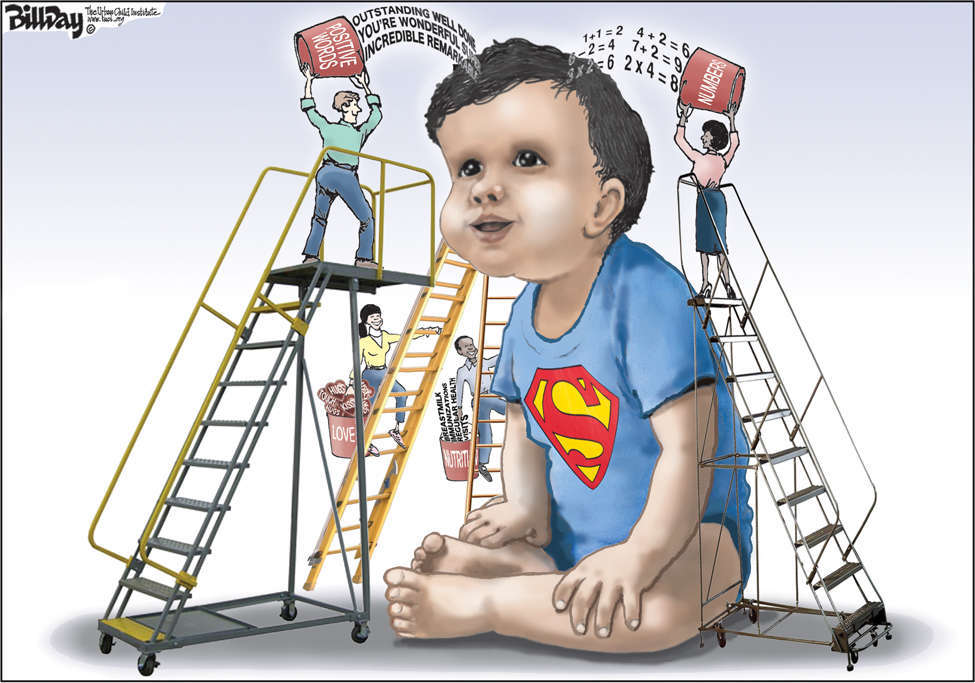Parents often ask what matters most in the raising of their young children.
The answer: Everything.
And the best child-rearing begins before the baby is even born.
A lot of parents believe that their children are born hard-wired for life, but the truth is that it’s the parents themselves that largely hard-wire their children.
Here’s the neuroscience: Most of a baby’s brain cells are formed during pregnancy, and by the time a baby is born, his brain has 100 billion neurons (brain cells). The brain adds comparatively few cells after birth. Instead, existing neurons sprout connectors to their neighboring neurons that lay the foundational wiring for the child’s development.
These connections form the equivalent of a brain’s computing power. In the first three years of a baby’s life, his brain is taking in all sorts of new input and acquiring new skills so that by the time he celebrates his third birthday, each neuron has formed as many as 10,000 connections, making a total of about a quadrillion (that’s a 1 followed 15 zeroes). That’s double the number of neural connections an adult has.
That’s why when a baby is born, her brain is firing like a high-octane performance engine. It accounts for the remarkable development that characterizes a child’s first three years. The same baby who was so utterly helpless at birth is babbling at six months and walking and talking as a toddler. In this same period of time, a baby’s brain is tripling in size and by the age of three, the toddler’s brain is more than twice as active as an adult’s.
As the baby begins to see better, to explore her environment, and to interact with adults, neurons in her brain transmit signals to each other. The neural networks that are used grow stronger, and those that aren’t wither away in a process known as pruning.
But the best hard-wiring of the brain begins in the womb, and that’s why negative effects on brain development have to be eliminated, such as drug and alcohol use, cigarettes, stress, depression, and poor nutrition. Good nutrition and prenatal visits are important in optimizing the likelihood of a full term birth. Low birth weight babies, most frequently due to premature birth or maternal smoking, increase risks for developmental problems related to physical health, psychological adjustment, and intellectual functioning.
So, what’s the best way to increase brain development? It’s not about expensive educational toys or videos. Rather, it’s about creating a nurturing environment where children are comforted, where they feel safe and secure, and where they are exposed to new experiences with parents, family, and caregivers that hold them, talk to them, sing to them, play with them, and read to them.
Children are trying to communicate long before they even learn how to form words. Communication develops in a baby’s environment with parents, family, and caregivers, and it is through the process of learning to speak, developing a vocabulary, and learning the give-and-take of communication that toddlers are prepared with confidence in their ability to express themselves by the time they enter kindergarten.
Children prepared and excited about kindergarten are then in turn interested in reading and learning, and the seeds for this interest are planted when parents encourage their child to look at words on a page, look at pictures in a book, and hold a marker to draw.
It’s why some activities may seem inconsequential at the time, but in truth, nothing is inconsequential when it comes to babies and toddlers. Everything connects to shape brain development, language and literacy skills, and ultimately, entire lives.
That why when we’re asked what matters most in child-rearing, we say everything.
Previously published as Perceptions by The Urban Child Institute. You can sign up to receive Perceptions





Thanks for the great article! As a teacher with unfortunately several pregnant teenage girls, I plan to take this information and start sharing it with my students so they can start incorporating it into their children’s lives.